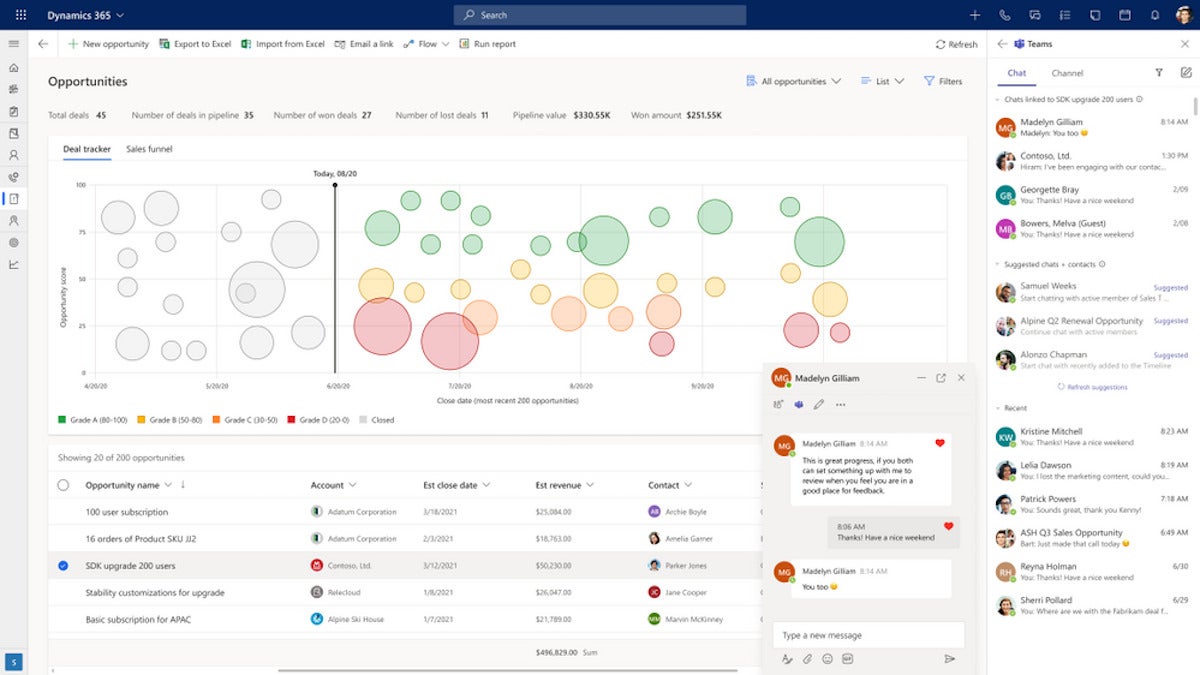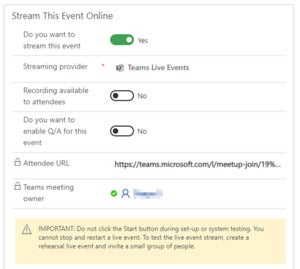advertisement
Microsoft Deepens Teams Ties With Dynamics 365

Microsoft unveiled deeper integrations between Teams and Dynamics 365 as the company moves to make it easier for sales and customer service staffers to communicate without switching between apps.
The company highlighted some of the integrations affecting its Dynamics 365 platform at its Ignite conference. Microsoft’s goal: collect and tie together data in a way that makes it actionable — and easier to share among workers via Teams.
“What stands out for me in this new wave of innovation we’re doing together across Dynamics 365 and with [Microsoft] 365 is this need to connect systems of record with systems of engagement in order to create these new opportunities for business workflows that can really digitize the way companies work,” Emma Williams, corporate vice president of Microsoft Office Modern Workplace Transformation, said during a session at Ignite.
advertisement
The closer ties between Teams and Dynamics 365 should have a significant impact for users of both apps, said Raul Castanon, a senior research analyst at 451 Research, part of S&P Global Market Intelligence. The integrations can enable a workflow-centric approach that reduces friction in day-to-day tasks and leads to improved efficiencies, he said.
“Rather than users switching between business applications to get their work done, enabling collaboration features within ERP and CRM applications aligns more closely with business workflows,” said Castanon.
“By Microsoft bringing Teams and Dynamics 365 closer together, distributed sales, service and marketing teams are able to collaborate far more efficiently,” said Kyle Davis, a Gartner Research vice president.
advertisement
For Dynamics 365 Sales, Teams chat can be embedded in the customer relationship management (CRM) app; sellers will also be able to continue one-to-one conversations with suggested colleagues working on a customer account and access team chats that mention the customer.
The embedded chat is also available in the Customer Service and Field Service modules within Dynamics 365, allowing customer support agents to communicate on subject matter more effectively.
Teams chats and channels are present in a side-panel display, alongside suggested chats and contacts based on colleagues working on a given account.
advertisement
 MICROSOFT
MICROSOFTAmong the other additions to Dynamics Sales is a Teams call dialler that lets sellers contact customers without switching screens. The call panel will also display real-time transcriptions of conversations with business-critical phrases and suggested actions highlighted, and offers a note-taking tool connected to the sales records. After the call, a summary with follow-up actions and call sentiment analysis is then created. (A similar experience is enabled for Teams video calls setup by the salesperson.)
There’s also a Dynamics Sales integration designed to make sales information more readily available in Teams, allowing users to search for and share customer records; they can then viewed and edited by colleagues in the collaboration app.
The features are due to roll out next month, Microsoft said.
 MICROSOFT
MICROSOFTThere were new Teams integrations with Dynamics 365 Marketing, too, with users able to set up, analyze and follow up on events hosted in Teams.
From here, marketers can decide whether to stream an event, choose which platform to use – including the new Teams Webinar function, also announced at Ignite – and select among options such as muting of attendee microphones or enabling post-event Q&As.
From the Teams app, it is possible to follow up with participants, with the ability to export attendee information to Dynamics 365 Marketing to view customer segments based on audience attendance, and coordinate future communications.
Microsoft also unveiled Teams integrations with Dynamics 365’s HR, Commerce, and Supply Chain Management apps.
Integrating Teams into the workflow of business app users has been a growing priority for Microsoft. It recently announced new ways to interact with SAP’s enterprise resource planning (ERP), HR, and CRM software from Teams. This will, for instance, enable SAP users to share information such as supplier details with colleagues without switching screens.
Microsoft is not the only vendor, however, that’s poised to combine collaboration capabilities with the systems of record that many workers use day-to-day.
Salesforce’s $27.7 billion acquisition of Slack late last year allows Salesforce to integrate the popular team chat app into its own business software, including its widely used CRM platform.
“This is not a Microsoft exclusive strategy,” said Davis. “Salesforce recently acquired Slack, who is positioned to offer similar experiences within its ecosystem.
“As these two major vendors in the CRM market are making similar moves, it solidifies the importance and demand for strong unified digital collaboration experiences across the processes and activities performed in CRM and the conversations in workstream collaboration tools,” he said.
While the timing of Microsoft’s integration announcements may seem like a reaction to Salesforce’s acquisition of Slack, Castanon said the changes are the result of a platform-based approach Microsoft has been developing for several years; they reflect a larger trend towards communication-enabled workflows.
“It also reflects that a platform-based approach can better address the requirements of several use cases — in this case, customer support — than a standalone communications tool,” he said.
In a related announcement this week, Microsoft unveiled Teams Connect, which will enable users to communicate with external clients and partners more easily via shared channels within Teams.
The feature could prove useful to those in sales, marketing and customer support roles, in particular. External collaboration for customer engagement is one of the key areas Microsoft could seek to tackle with shared channels — including customer support, sales and marketing, said Castanon.
“The integration of Dynamics 365 with Teams, enhanced with the capabilities that Connect-shared channels enable, should allow organizations to streamline and build efficiencies in workflows for customer service representatives and support agents,” he said.